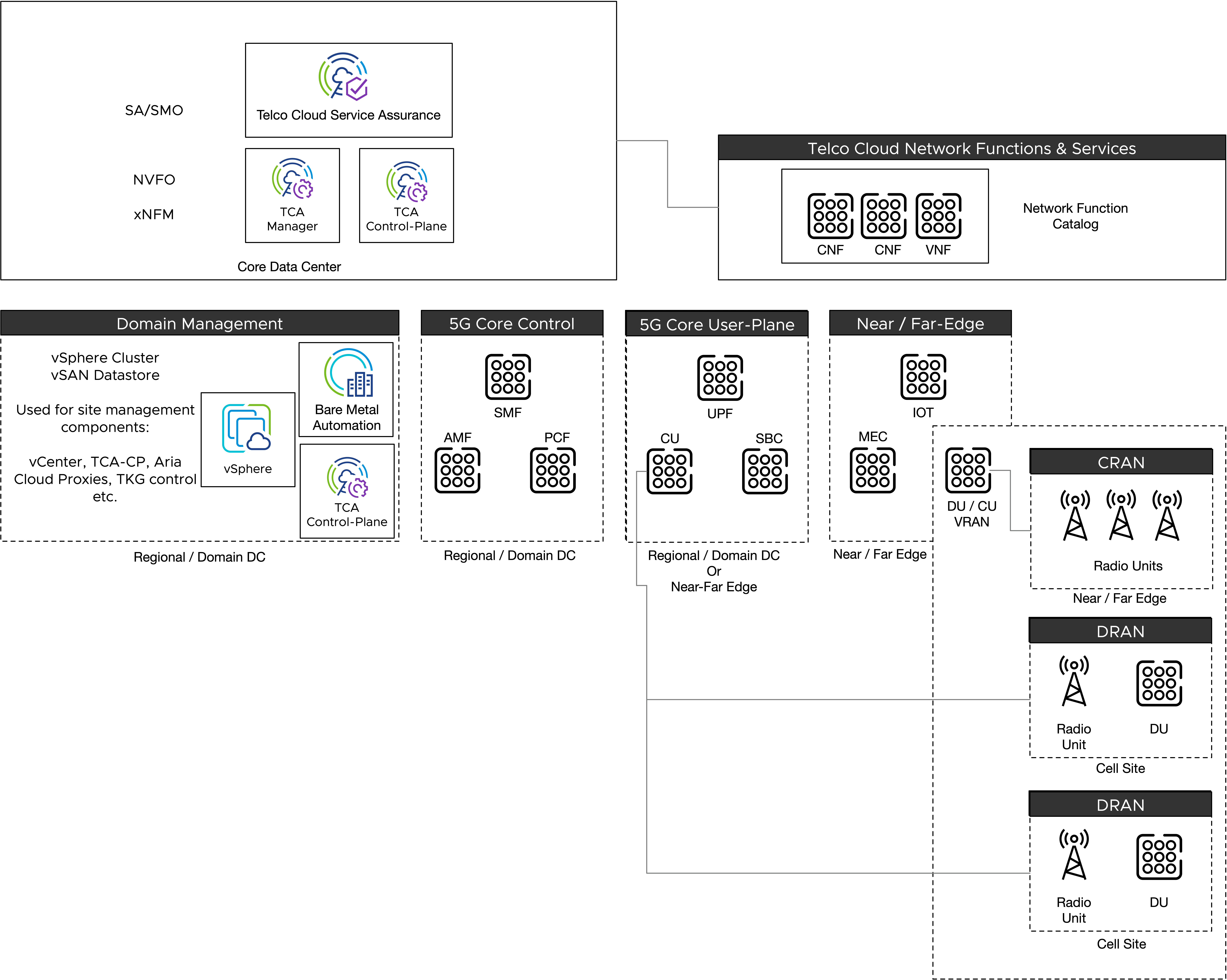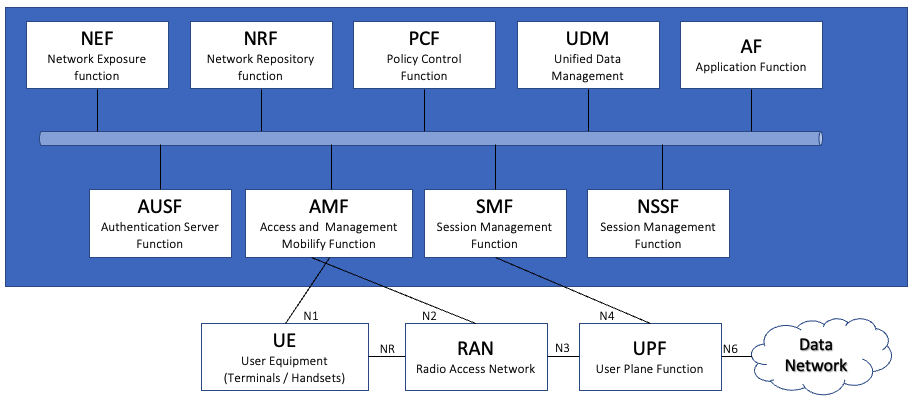This section provides an overview of the deployment topologies and considerations for 5G Core and RAN architectures commonly used by Communication Service Providers (CSPs).
5G Multi-Tier and Distributed Architecture
VMware Telco Cloud is a common platform from Core to RAN. This common platform can adapt and scale automatically depending on the workload deployed through VMware Telco Cloud Automation™.
To deploy all workload types such as VNFs and CNFs from 4G and 5G Core to RAN (including 4G Control functions, 4G EPC functions, 5G Core functions, and RAN DU/CU functions), the same infrastructure components, automation platforms, operational tooling, and CaaS infrastructure is leveraged end-to-end.
The 5G network must be dynamic and programmable to achieve business objectives. Network operators must be able to provision virtual network slices on-demand with QoS. This helps meet SLAs, provision functions to increase capacity using industry-standard APIs, and re-route traffic during congestion pro-actively and securely.
To handle the massive data traffic, 5G is designed to separate the user plane from the control plane and to distribute user plane functions as close to the end user device as possible. As the user traffic increases, operators can add more user plane services without changing the control plane capacity. This distributed architecture can be realized by building the data center and network infrastructure based on hierarchical layers. The following diagram illustrates a hierarchical 5G design.

Applications such as RAN cell sites, sensors, and smart devices can reside on the network edge.
Far Edge: The network far edge is the aggregation point for the geographically distributed radio sites hosting RAN and IP routing aggregators. It might also host mobile edge computing software to support private 5G use cases for factory automation, remote presence, and so on. Access mobility and user plane termination functions of the 5G core can also reside in the far edge. The type and number of applications that can be hosted in the far edge sites are limited by available power and space.
Near Edge: The near edge is the aggregation point for far edge sites. It hosts many of the services as the far edge. It also serves as a peering point to access the Internet or other infrastructure-related cloud services. In a distributed 5G Core, the UPF can be deployed at the near-edge for distributed break-out points for efficient internet and off-ramp connectivity.
The central or core sites hosts infrastructure components such as the VMware Telco cloud management components, Kubernetes Management clusters, CICD toolchains, Operational Support Systems (OSS), Observability platforms, Kubernetes image repository, and so on.
Depending on the 5G deployment, control plane functions of the 5G core, subscriber database, and so on, can reside in the core or regional data center.
RAN Architectures
The RAN network must adhere to the multi-tier and distributed architecture of the 5G Core and the specifications of the RAN environment.
The model of the Telco Cloud architecture allows CSPs to scale 5G deployments based on application requirements and user load. Modern Telco architecture consists of four levels: 5G subscriber databases, data repositories, resource orchestration, and service assurance are typically hosted in the Central, or core data centers. The central and regional data centers also serve as peering points for lawful intercept points. For redundancy, a pair of central data centers are deployed in geographically diverse sites.

In this diagram, the regional or domain data centers host the 5G core user plane function, voice services functions, and non-call processing infrastructure such as IPAM, DNS, and NTP servers. Inbound and outbound roaming traffic can also be routed from the regional data center, out towards the edge. With the inclusion of RAN/DRAN, the distribution of user plane functions becomes more visible.
The Telco Cloud Platform is a compute workload domain that can span from the Core and Regional / Domain Data Centers to individual cell sites.
DRAN architecture: The Cell site uses the Distributed RAN (DRAN) architecture. This architecture uses single hosts, distributed across thousands of remote cell sites. However, more complex architectures for cell-sites (with redundancy) can be used.
CRAN architecture: Near edge sites can implement a Centralized RAN (CRAN) architecture. This architecture uses a cluster of hosts for high availability, resiliency, and scale. In the CRAN model, RAN functions are deployed outside of the cell sites.
For more information about these two architectural models, see Telco Cloud - RAN Domains.
To support new applications and devices that require ultra-low latency, localized processing, and high-throughput networks, CSPs can push the 5G user-plane closer to the application edge. At the same time, RAN dis-aggregation enables efficient hardware utilization and pooling gain and increases deployment flexibility while reducing the Capital Expenditure (CAPEX) and Operational Expenditure (OPEX) of Radio Access.
The core sites (Central, Regional, and Edge sites) are part of the 5G Core architecture, while the far edge or cell sites are also commonly part of the RAN architecture for CRAN and DRAN.
5G Service-Based Architecture
5G comes with the specification of a Service-Based Architecture (SBA). The basic principles of SBA are independent of vendors, products, and technologies. A service is a discrete unit of functionality that can be accessed remotely, acted upon, and updated independently. SBAs improve the modularity of products. The network functions creating the 5G service can be broken down into communicating services. With this approach, users can deploy services from different vendors into a single product.
The following diagram illustrates various 5G Core Control Plane functions. The UPF and RAN components are User Plane Functions responsible for radio control, packet routing, Deep Packet Inspection (DPI), and other router-based functions.

Containers are used as a portable and lightweight virtualization solution for 5G Service-Based Architecture (SBA). Kubernetes is one of the components to consider when delivering Carrier-Grade Container as a Service (CaaS). 5G Core network functions are deployed in a cloud-native form although VM-based components can also exist.
A Carrier-Grade CaaS platform requires a complex ecosystem of solutions and functions to form a pre-set business and operating model. The cloud infrastructure modernization changes not only the business model in service agility and metered revenue models but also challenges the silo operating model.
5G Core and RAN Connectivity Considerations
The following core and edge connectivity considerations are required to support different deployment models of 5G RAN:
Core and Edge connectivity: Core and Edge connectivity have a significant impact on the 5G core deployment and it provides application-specific SLAs. The radio spectrum type, connectivity, and available bandwidth also have an impact on the placement of CNFs.
WAN connectivity and Bandwidth: In the centralized deployment model, the WAN connectivity must be reliable between the sites. All 5G control traffic travels from the edge to the core, so any unexpected WAN outage prevents 5G user sessions from being established.
The fronthaul traffic forwarding from the Remote Radio Unit (RRU) to the DU can be significant in a DRAN environment, so an appropriate bandwidth and infrastructure sizing is required. The WAN sizing and redundant connectivity requirements need to be based on the maximum expected throughput, as required Quality of Service (QoS) can be deployed to protect high-priority traffic between the RAN and Far Edge / Core sites.
Components deployment in Cell Site: Due to the physical constraints of remote Cell Site locations, deploy only the required functions at the Cell Site and the remaining components centrally. For example, observability and logging functions are often deployed centrally to provide universal visibility and control. Non-latency-sensitive user metrics are often forwarded centrally for processing.
Network Routing and Local Break-out: Each cell site or far-edge site routes the user plane and Internet traffic through the local Internet gateways, while the device communication involving management and non-real-time sensitive applications leverage the core.